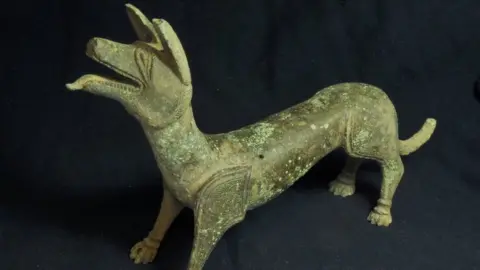Government to 'redefine treasure finds' in England and Wales
 DCMS
DCMSPlans aimed at protecting newly-uncovered treasure in England and Wales have been unveiled by the government.
Changes to the 1996 Treasure Act will see artefacts defined as treasure if they are of historical or cultural significance.
They are intended to ensure significant artefacts are not lost to the public and will instead be able to go on display in museums.
The move follows the growth in popularity of metal detecting.
Under the pre-existing rules, objects are classified as treasure if they are found to be more than 300 years old, made of gold or silver, or found with artefacts made of precious metals.
The Department for Digital, Culture, Media and Sport (DCMS) said a number of Roman finds on UK soil had not met the current criteria for the definition of treasure.
Dog made of lead sold
"The search for buried treasures by budding detectorists has become more popular than ever before and many ancient artefacts now see the light of day in museums' collections," said culture minister Caroline Dinenage.
"However it is important that we pursue plans to protect more of our precious history and make it easier for everyone to follow the treasure process."
Once they have officially been identified as treasure they become the property of the Crown and can be acquired by museums for public display.
The DCMS said the new rules would have protected discoveries like that of a Roman figurine, depicting a British person, found near Chelmsford, Essex, in 2014.
The artefact, now in the Chelmsford City Museum after an export licence delayed its sale, would not have previously met the definition of treasure because it is made from a copper alloy.
 PA
PAThe department added that a bronze Roman statue of a dog found in Gloucestershire by metal detectorists in 2017, was sold to a private collector as part of a hoard as it was not made from precious metal.
"Although it was of outstanding archaeological importance, the dog did not fall under the definition of treasure in the 1996 Act because it was made of lead," the DCMS said.

Follow us on Facebook, or on Twitter @BBCNewsEnts. If you have a story suggestion email [email protected].
